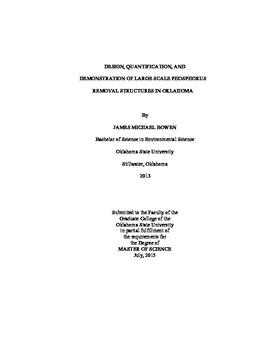| dc.contributor.advisor | Penn, Chad J. | |
| dc.contributor.author | Bowen, James Michael | |
| dc.date.accessioned | 2016-09-29T18:38:43Z | |
| dc.date.available | 2016-09-29T18:38:43Z | |
| dc.date.issued | 2015-07-01 | |
| dc.identifier.uri | https://hdl.handle.net/11244/45235 | |
| dc.description.abstract | Phosphorus (P) lost from agricultural and urban soils can enter waterways causing eutrophication resulting in reduced water quality. Conventional best management practices (BMPs) are effective at reducing particulate P loss, but do little to stop dissolved P which is 100% bioavailable. The use of landscape filters filled with materials that have a high affinity for P, i.e. P sorbing materials (PSMs), has been shown to reduce transport of dissolved P. These studies examined the process of using a previously developed model to design a P removal structure to meet removal goals. Specifically, we designed, constructed, and monitored a P removal structure on a poultry farm using the model, compared the model predictions for P removal to measured P removal, and also integrated the design process, including the model, into the Phosphorus Removal Online Guidance (PhROG) design software. The poultry farm structure has removed 57.5% of the P load during the first 21 months of operation which exceeds the goal of 45% cumulative removal for 1 y. The discrepancy in removal is due to an over estimation of the annual P load. The model predictions based on the current P loading are in agreement with the measured removal. The results from this structure were also used in validation of the model. The measured discrete P removal curve from a total of 14 sets of observations, including laboratory flow-through, a pilot-scale structure, and other field structure experiments, were found to be not significantly different from the model predictions. The validation of the model was critical since it is the foundation of the PhROG design software. In order to aid the user, a handbook that details the inputs required and how they affect structure design was created. This software is the culmination of years of research into the design and construction of these structures that aims to make the design process approachable and easy for the layperson. P removal structures are a viable BMP to reduce transport of dissolved P and can be designed to meet removal goals safely and effectively. | |
| dc.format | application/pdf | |
| dc.language | en_US | |
| dc.rights | Copyright is held by the author who has granted the Oklahoma State University Library the non-exclusive right to share this material in its institutional repository. Contact Digital Library Services at lib-dls@okstate.edu or 405-744-9161 for the permission policy on the use, reproduction or distribution of this material. | |
| dc.title | Design, Quantification, and Demonstration of Large Scale Phosphorus Removal Structures in Oklahoma | |
| dc.type | text | |
| dc.contributor.committeeMember | Brown, Glenn Owen | |
| dc.contributor.committeeMember | Fox, Garey A. | |
| dc.contributor.committeeMember | Warren, Jason G. | |
| osu.filename | Bowen_okstate_0664M_14218.pdf | |
| osu.accesstype | Open Access | |
| dc.description.department | Plant & Soil Sciences | |
| dc.type.genre | Thesis | |
